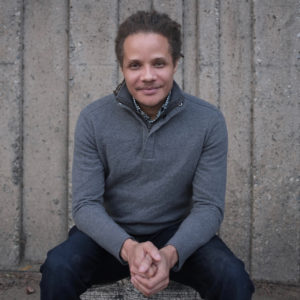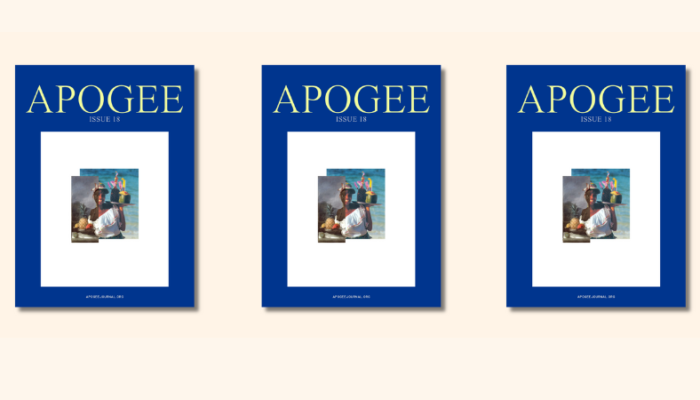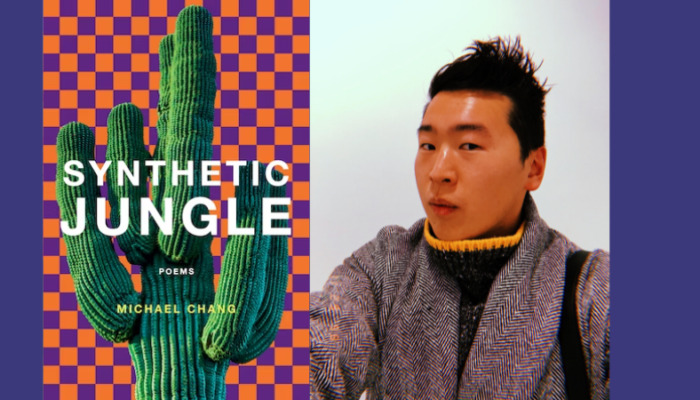Jamel Brinkley in Conversation with Crystal Hana Kim
When I began Jamel Brinkley’s debut collection, A Lucky Man, I read slowly to draw out my time with his stories. I was astounded by the beauty and heartbreak in each scene, from teenaged Ty who wanders Brooklyn searching for an all-night revel with his younger brother in tow, to middle-aged Lincoln who has taken on the habit of surreptitiously photographing women on the train. At the same time, I felt an expansive quality to Jamel’s work; though it’s clear that he pays attention to each sentence, his characters don’t feel overly crafted or precious. These men are nuanced and complicated; they feel real.
Jamel and I spoke about performance as a response to authenticity, the societal strictures placed on young black boys in America, the writing process, capoeira, Baldwin’s “Sonny’s Blues” and more over the course of a few days. There was so much I wasn’t able to touch upon, so much more we could have discussed. The emotional complexity and lyrical precision in Jamel’s stories astonish me, and I hope readers will buy a copy of this book so that they will be able to discover the power of A Lucky Man for themselves.
— Crystal Hana Kim
Crystal Hana Kim: I think this is a stunning story collection—every story felt perfectly crafted, each ending resonates. There are so many lucid, fresh descriptions, like this one: “A neat, lady-like Afro bloomed form her head, and she was a darker brown than her friend with the buzz cut, a thick snack of a girl whose shape made you work your jaws.” The writing commands that we pay careful attention. How long have you been working on these stories?
Jamel Brinkley: Well, thank you, first of all. It’s especially gratifying to hear that coming from a fellow writer, and an accomplished one, at that. I try to pay a lot of attention to my stories on the level of the sentence, to the sounds and rhythms they make or suggest for readers. If we go by the initial drafts of the stories, the oldest one in the collection is “Infinite Happiness,” which I began in 2012. The newest stories are “I Happy Am” and “Wolf and Rhonda,” which emerged in 2015.
CHK: 2012 to 2015 is a decent range of time! When did you know know your collection was done? And even before that, how did you know when each story was done? I always want to mess with my writing, to tweak the dialogue or a metaphor, and it’s hard for me to know when I’m done. I know these might be two impossible questions to answer, but I had to ask!
JB: Every time I reread one of my stories, I find something I want to change. Every time. In that sense, I don’t think my stories are ever really “finished.” They’re just in good enough shape that they can more or less fend for themselves out in the world. Hopefully they’ll make lots of friends, but I’m sure they’ll get roughed up some too. In terms of the collection as a whole, I had no idea it was done. I was sending them individually to my literary agent as I revised them, and one day she said, “I think we’re ready to go!” I said, “Go? Where are we going?” I had no idea what she was talking about. At that point I had sent her seven stories, and since my stories tend to be long, she felt I had enough to start sending to book editors. I had two more stories in my revision queue, but she forced me to send them to her ASAP. She knew I would have kept them and tinkered with them forever. We went with those nine, one of which got pulled and replaced during the editorial process. I don’t think the stories really started to feel like a collection for me until I had discussions with my agent, and then my editors, about story order. Then I began to see the shape of a potential book, ways the stories spoke to one another, and a journey from beginning to end that made some sense.
CHK: I’m always curious about how an author decides to order their stories, and I wondered about the order in A Lucky Man as well. There are so many connecting themes here, and one that I noticed right away was authenticity—of manhood, of blackness. In the first story, “No More Than a Bubble,” the narrator Ben and his friend Claudius go to a party in Brooklyn. Ben seems fixated on both authenticity in himself and those around him. There’s this line: “We both preferred girls of a certain plumpness, with curves—in part, I think, because that’s what black guys are supposed to like. Liking them felt like a confirmation of possessing black blood, a way to stamp ourselves with authenticity.” The reader later finds out that Ben’s father is a white Italian man and his mother is a black woman. Their racial identities hover throughout the story, bleeding into Ben’s consciousness and actions. Was the question of authenticity something you were actively thinking about throughout these stories?
JB: As I worked on “No More Than a Bubble,” authenticity was certainly something that became important. The age of the two guys is key, being young college students, supposedly on the cusp of manhood, probably thinking they already are full-fledged men, and therefore taking on or pursuing whatever dominant notions out there define them as men of a certain kind. But not just men, right? Black men in particular, supposedly heterosexual (in the story, aggressively and performatively so). Attending a predominantly white institution like Columbia University presents a specific kind of context, a stage on which young black people wrestle with race, sexuality, and gender. Maybe performance, rather than authenticity, is closer to the core of what the story is about. Or maybe performance is one possible answer to the question of authenticity posed by the story. Performance–and related concepts such as pretending and playacting–certainly seems to be a thread that runs through many of the stories, maybe even all of them.
In terms of story order, my editors and I settled on “Bubble” as a starting point for a few reasons. The voice and energy of the story, hopefully, will grab readers. Also, it seeds many of the concerns of the collection as a whole: performance, which I just mentioned; masculinity; relationships (familial or otherwise) between black men; black sons and their fathers and mothers; sex and sexuality; a kind of pleasure-seeking riskiness or recklessness. (The title of the story comes from Denis Johnson’s “Car Crash While Hitchhiking.”) I also like that the story begins with a gathering and music. The last story, “Clifton’s Place,” ends with a gathering and music as well, albeit with a very different mood. I didn’t plan it that way, but I’m glad that’s the way it worked out.
CHK: I was wondering where the title came from! You’re right that performance is the core of “No More Than a Bubble,” and of many of these stories. Authenticity, performance, and masculinity are so closely woven together for your characters, and of course, it also has to do with race and power—the way they look, the color of their skin, and the way they are viewed by society.
In the penultimate story, “Wolf and Rhonda,” Wolf is described as a popular boy “because of his brashness, the unpredictable ways he performed being black and male.” And then Wolf changes in college in Florida, “with increasing numbers of white people, people unlike those he’d grown up with in Mott Haven, his performance was by turns more timid and more exaggerated.”
Similarly, you mentioned earlier that being in a predominantly white institution presents “a stage,” a specific kind of context for Ben and Claudius to be aware of as they work through the questions of sexuality and identity that all young twenty-something adults go through.
Your story collection shows the many ways our society paints and restricts young black boys’ images of themselves, which then can lead to performance. Does that make sense? Is this something you were actively thinking about while writing?
JB: It does make sense, and you’ve put it nicely. I must have been aware of it, but only on a subconscious level. One of my writing teachers likes to say that theme is what happens only when the story cools down, when it’s at rest, after the intensity and immersion of writing and reading are done. That seems true to me, and it is true in my practice. I don’t write well when I’m led too much by thematic concerns. While writing the stories in this collection, I was actively thinking about character and action and place, all the things that keep a story heated and in motion. I didn’t set out to write a bunch of stories that all touch upon race, racism, and performance in a cohesive way, but of course these ideas must have been in my mind somewhere. It makes sense that they would be all over the collection though. It’s fascinating to me how people—particularly black people and other people of color, but all people really—perform their layered identities.
CHK: I love that idea—theme happens only when the story cools down. One of the things I loved about this collection is your attention to each character. I could feel how deeply you knew, thought about, and felt for Ben, Ty, Freddy, Eric, Curtis, Lincoln, AJ, Wolf, Ellis… You ask the reader to consider questions about gender, sexuality, family, racism and what it’s like to move through our society as a black man by forcing us to pay attention to these individuals and their stories. These characters speak about police brutality, oppression, the incarceration of black males. But it doesn’t ever feel like an agenda on your part.
You said you think about character and action and place, not themes. What’s the writing process like for you? Do you start with a character or an incident or maybe the ending? Does it change with each story?
JB: I never start with the ending. I’m one of those story writers who likes to discover the ending along the way, ideally as close to the last page as possible. Hopefully if I don’t see the ending coming way in advance, the reader won’t either. I want my endings to issue from the full complexity of the story, and I want to be able to take all that complexity into account before I start to think about how the story will close. I’m happiest when it feels like the story itself is telling me how it will end.
Some of what I start with are certainly things that have stuck with me from my own life. So, for example, I was in a day camp much like the one Freddy from “I Happy Am” is in and we (black and brown kids) did go to the suburbs to swim in white people’s pools. I’ve been to J’ouvert in Brooklyn. I used to be very actively involved in capoeira angola. The bar in Clifton’s Place is based on a bar I’ve been to in Bed-Stuy. And so on. Some stories pull more from my life than others. But if I borrow anything from “real life,” whether it’s a type of character or a place or a name, then I try to make sure I quickly loosen it from the grip of (auto)biography so that I’m free to invent around it. Sometimes I do start with a made-up character or with a voice, and sometimes I’m writing in response to other stories. “Everything the Mouth Eats” is, in many ways, one way I’ve responded to “Sonny’s Blues” by James Baldwin. “A Family” is a kind of response to “Gold Boy, Emerald Girl” by Yiyun Li, which itself is a response to “Three People” by William Trevor.
CHK: Ah, so you’re creating conversations with other authors! I love stories that respond to or react to other stories. “Everything the Mouth Eats” is one of my favorites in this collection. There are so many layers, so much to unpack—it felt almost novelistic at points. I haven’t reread “Sonny’s Blues” since my MFA days, but I can see the similarities, especially in the difficult sibling dynamic between Eric and Carlos, how they come together after years of estrangement, and how the extended flashback is used in the middle of the story. I don’t want to spoil the story for your readers, but could you tell us a little more about how you were responding to “Sonny’s Blues”?
JB: I want to tread carefully here, because “Sonny’s Blues” is such a miracle of a story. It works in ways I’m still trying to figure out, but probably never will. Other than what you’ve already noted, I’ll mention that capoeira angola, in my story, tries to do some of the work that music does in Baldwin’s story. In an analysis of “Sonny’s Blues,” Antonya Nelson writes about the ways that music (which intensifies from beginning to end) and the distance between the two brothers (which lessens from beginning to end) gives the story, which is mostly plotless, a shape that makes it cohere. Capoeira is a martial art, a game, a dance, and, for serious practitioners, a way of life. As I wrote and then revised “Everything the Mouth Eats,” I wanted to take advantage of and pay homage to capoeira’s dynamic, multi-dimensional character. Fighting, playing games, and dancing are all a part of the history between Eric and Carlos. Ginga, the basic movement of capoeira, has been described as a kind of swinging or swaying, and I wanted the structure of my story, oscillating from present to past, to mirror that movement a little bit.
But maybe the main way I eventually realized I wanted to respond is to see if I could get my brothers, at the end, if only temporarily, even closer than Sonny and his older brother are at the end of Baldwin’s story. My narrator can’t just witness his brother’s skill and emerging mastery, he has to physically experience it for himself. But like I said, “Sonny’s Blues” is a miracle, written by a genius, and my arms are too short to box with God.
CHK: I think there’s so much beauty in “Everything the Mouth Eats,” and I can definitely see how you used capoeira in place of music.
I know very little about capoeira though, and I was intrigued throughout the story of how all-consuming this sport, or should I call it a dance?, seemed to be for Carlos. As a writer, I was interested in the Portuguese songs you place throughout the story. The title “Everything the Mouth Eats” and the words to the songs are written only in Portuguese in the story. Do you expect or hope the reader will translate the lyrics as they read? Does that matter to you?
JB: I like the idea of readers having to be active, and as a writer I don’t want to do too much hand-holding. So yeah, I do expect readers to translate the lyrics if they don’t already understand them. Google makes that kind of work not much work at all, but even a tiny bit of resistance of that kind matters to me. We use the phrase “the reader” a lot in literary circles, but who does it really imply? Probably someone white, American, straight, monolingual, often male, and so on. And there’s pressure, implied or explicit, to bend over backwards to pander to that presumed reader. It’s crap. I remember once, in a writing workshop, the proceedings got stuck in quicksand because I had a character say “Booboo the Fool” in a story. Again, for those unfamiliar with that reference, Google would have been a quick solution. But the refusal on the part of some folks to do even that, and to expect the story to spell it out for them, to spend time faulting the story and its writer for not spelling it out, was total nonsense.
CHK: I completely agree here. First, it’s important to trust the reader, to hold them to high expectations. When I’m reading, I dislike fiction that hand-holds and overexplains. It takes me out of the voice and story. Second, you’re right—the presumed “reader” discussed in literary circles is probably white, male, straight, cisgender, upper-middle class, etc. It’s not the writer’s responsibility to explain for that reader. The writer’s responsibility is to stay in the world of the narrative. My novel has a lot of Korean words throughout, and those words are not italicized or followed by a definition because that’s not how the characters would think or speak!
I’d love to transition to reading in general here. Do you read while you write? I know some writers don’t like to because they’re afraid of too much influence or contamination.
JB: I do read while I write. In fact, if I’m stuck with my own work, reading the work of others is often exactly the thing I need to get going again. I’m not super afraid of influence or contamination, because if that happens while I’m working on a first draft, in subsequent drafts I know I can always address the way the story sounds or is angled stylistically. Whether I’m able to successfully address those matters is another question, of course!
CHK: And what about now during this post-publication period? What are you reading? What books are you excited about?
JB: Right now I’m reading There There by Tommy Orange, which is great. I’m also reading Asymmetry by Lisa Halliday and poetry by Jenny Xie and Tarfia Faizullah. I’m always revisiting favorites and dipping into journals. On deck I have Wade in the Water by Tracy K. Smith and An American Marriage by Tayari Jones, just to name two; that pile of books I plan to read next is tall and ever-growing. I’m excited about a number of books by fellow 2018 debut fiction writers: you, Renee Simms, Alexia Arthurs, Fatima Farheen Mirza, Novuyo Rosa Tshuma, Lillian Li, Nafissa Thompson-Spires, Lucy Tan, and D. Wystan Owen, among others. I’m looking forward to reading some older books as well.
CHK: So many of those books are on my to-read list also! I’m halfway through Lillian Li’s Number One Chinese Restaurant now, and I’m loving it. Tarfia’s poetry makes my heart stop every time. Going to add the rest of your recommendations to my list now too.
There’s so much more I’d love to talk to you about—we’ve really only skimmed the surface of your stories, but I think we should wrap up. One last question. You recently received a Stegner Fellowship! Congratulations! Do you know what you’ll be working on while at Stanford?
JB: Thank you! I’m very excited about the opportunity. I know I want to work on a novel or a novella. My plan is to try to complete a full draft of the longer project before I workshop any of it, so that probably won’t happen until my second year there. In the meantime, I definitely want to work on new short stories. All the new work I have in mind is at that very delicate stage where I shouldn’t say very much about it.
CHK: A novel or novella! I’m so excited for you. And I’m excited for our readers to discover all of the beauty and complexity in your short story collection, A Lucky Man!
Jamel Brinkley was raised in the Bronx and Brooklyn, New York. He is a graduate of Columbia University and the Iowa Writers’ Workshop. His work has received fellowships from Kimbilio Fiction and the Wisconsin Institute for Creative Writing. Beginning this fall, he will be a 2018-2020 Wallace Stegner Fellow in Fiction at Stanford University.





